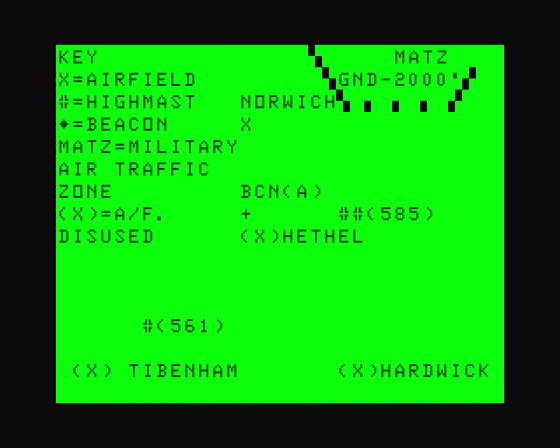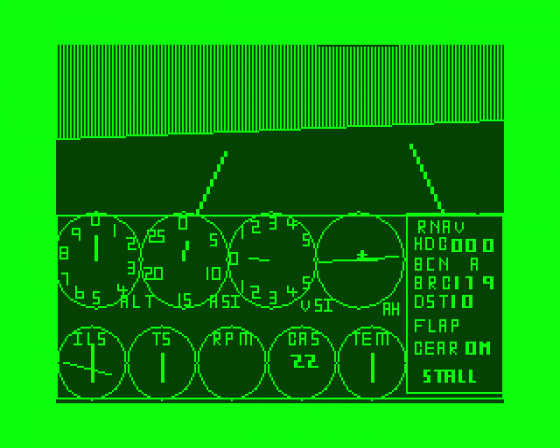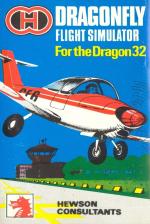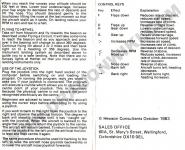



| Genre: | Simulator; Light Aircraft |
| Publisher: | Hewson Consultants |
| Cover Art Language: | English |
| Machine Compatibility: | Dragon 32, Dragon 64 |
| Release: | Professionally released on Cassette |
| Available For: | Dragon 32 |
| Compatible Emulators: | XRoar 0.33.1 (PC (Windows)) |
| Original Release Date: | 4th October 1983 |
| Original Release Price: | £6.95 |
| Market Valuation: | £2.50 (How Is This Calculated?) |
| Item Weight: | 64g |
| Box Type: | Cassette Single Plastic Clear |
| Author(s): | - |
Variant Items
There are 2 other items featuring this same game (that we know about!). Click any of them for their details.
Active Auctions
Closed Auctions
Buy It
Unfortunately no-one is currently selling this item.
Auction Price Watch
Worried you're being ripped off? Closing prices on eBay can help you decide what a reasonable price is for a particular item.

Home Computing Weekly
4th October 1983
Fairly easy to take off, but even easier to crash - which I did with monotonous regularity every time I tried to land. Read Review

Personal Computer News
29th September 1983
If you look at Microdeal's Space Shuttle, Dragonfly bears as much resemblance to that excellent program as Norwich airport bears to Cape Kennedy. Read Review
Full Instructions
Scenario
You are the pilot of a light aircraft on the runway at Norwich airport. You have been given clearance to fly a circuit and land back at Norwich or to fly south down to Hethel and land there. There is a radio beacon at Hethel and this will guide you on either flight.
Flying A Circuit
When the program is first run you are stationary on the runway at Norwich. To start taxing, increase power up to the maximum of 3,000rpm, the stall light will flash until your airspeed is sufficient for you to take off safely.
Raise the nose one point and then the undercarriage. Raise the nose further and notice your altitude increase and the positive value of your verticle speed indicator. Having attained an altitude of about 100ft, continue to climb and put on two lots of right bank. Notice the artificial horizon indicate the bank. Continue banking until your heading is indicating 180 degrees. With small adjustments, alter your heading until the bearing to the beacon is steady. When your altitude is above that of the highest mast in the area, 585ft, bring the nose down to level and reduce rpm to 1,500 to maintain level flight.
Watching your distance measuring equipment (DME) you will notice you are closing in on the beacon. Norwich airstrip is 10 miles from the beacon, so allow yourself to get within 6-7 miles of the beacon and then bank right to bring your heading round to 360 degrees and the bearing from the beacon to 179 degrees. This is the bearing of the runway. Reduce engine rpm to 500 or 1,000 and lower the nose to reduce height. The instrument landing system (ILS) indicates whether you need to bank left or right to obtain a bearing of 179 degrees, remember to straighten up on to a heading of 360 degrees, or you will fly across the line, not along it. *When you are lined up* with the ILS a horizontal bar will appear, this indicates the position of the ideal glide slope relative to the aircraft. Reduce engine rpm to 500 and wait for your airspeed to drop below 125. Lower the flaps and undercarriage, and you are now set up to land.
Adjust flaps, nose and rpm to remain on the ideal glide slope (horizontal bars either side of the 'I').
When you see the runway lights and your altitude is below 40ft, put the aircraft nose in the level position and reduce rpm to zero. You should now descend onto the runway and taxi to a halt.
Flying Down To Hethel
Take off and obtain a heading of 180 degrees as before. As you get close to the beacon at Hethel (within 1.5 miles), the bearing will become nonsensical. Continue on a heading of 180 degrees and the bearing will settle down. Once you have passed the beacon, the DME wil give a positive reading as you fly away from the beacon.
Continue flight until you are 2 to 3 miles past the beacon, bank right and obtain a heading of 359 degrees and a bearing of 359 degrees. Land as before, but note there are no lights at Hethel.
Note
When close to beacon: BRG & DME are inaccurate. The bearing to beacon from Norwich A/F is 179 degrees. The bearing to beacon from Hethel A/F is 359 degrees. Engine stops if A/C is inverted. Restart in normal manner.
All headings given assure Zer wind velocity greater than zero has been input, choose a heading to maintain desired bearing.
Aerobatics
Loops, rolls and inverted flight are possible, but note that the engine stops if the aircraft is inverted and needs to be started in the normal way.
Wind
The wind blows from 280 degrees in strength from 0 to hurricane.
Instrument Panel
Instruments Indicates ~~~~~~~~~~~ ~~~~~~~~~ A/H Artificial Horizon Atitude and Bank of aircraft ASI Air Speed Indicator Speed in Knots ALT Altimeter Altitude in Feet VSI Verticle Speed Verticle Speed in feet per second ILS Instrument Landing System Position of Centre Line of runway and ideal glide slope relative to the aircraft HDG Heading Aircraft Heading in degrees DME Distance Measuring Equipment Distance to the Beacon in miles STALL Light Flashes when stall is likely FUEL Remaining Fuel in tank RPM Revs per Minute Engine RPM FLAPS Amount of Flap
Game Controls
Key Function Effect ~~~ ~~~~~~~~ ~~~~~~ E Flaps Down Reduces rate of descent, reduces stall spped, increases rate of climb D Flaps Up Reverse of above H Gear Down Lowers Undercarriage G Gear Up Raises Undercarriage > Increases RPM Increases air speed, increases rate of climb, decreases rate of descent < Decreases RPM Reverse of above Arrow Up Nose Up Reduces speed, increases rate of climb, decreases rate of descent Arrow Down Nose Down Reverse of above Arrow Left Bank Left Aircraft turns left, heading decreases Arrow Right Bank Right Reverse of above
You may use a joystick in the right hand socket.
Screen Designers
The following utilities are also available to allow you to edit the supplied screens of this game:
Cheats
Download
Report A Problem
We thank you from the bottom of our hearts if you report something wrong on our site. It's the only way we can fix any problems!
You are not currently logged in so your report will be anonymous.
Add Note
Release Country
Change the country to update it. Click outside of this pop-up to cancel.
Scan Of Selected Article
If you auction an item, it will no longer show in the regular shop section of the site.








